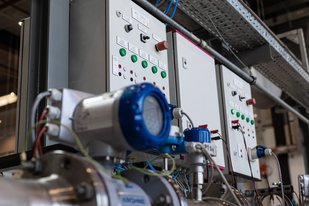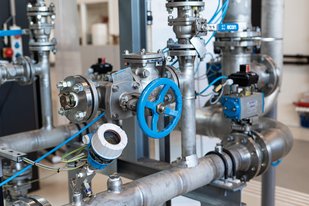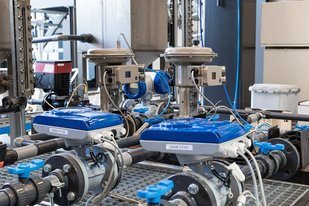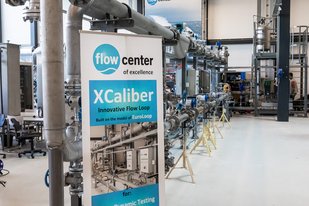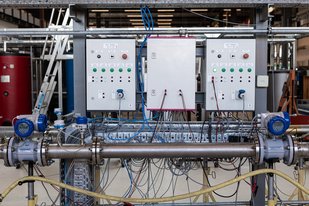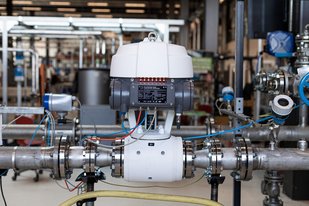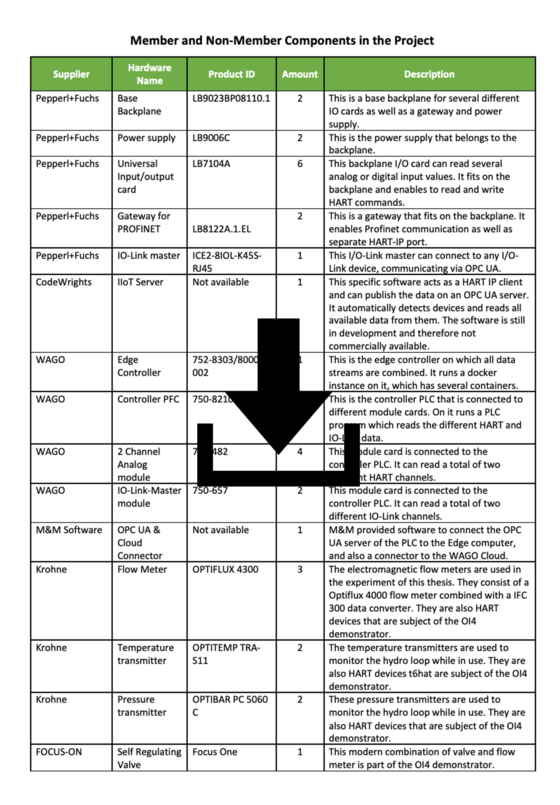OI4 Demonstrator for Process Industry - Sustainability Factory in the Netherlands
Faster together: The power of the OI4 Alliance community
The process industry, whether in oil and gas or chemicals and pharmaceuticals, has very complex production plants where every single improvement pays off in hard cash. Given the many challenges - such as optimised production, CO2 balancing and energy savings – the move to Industry 4.0 is a "must" today. Using the example of an existing model plant at the Flow Centre of Excellence inside the Dutch Duurzaamheidsfabriek* (Sustainability Factory), the Open Industry 4.0 Alliance demonstrated that Alliance members can work together to accelerate the transformation. It took just under three months from the idea for the integration project to the first provisional results. However, the project is not yet over after this milestone was achieved. Other members will contribute and further elaborate on the example of best practice. The project was awarded the first OI4 Implementation Award. The benefits are obvious for any company that decides to join this implementation alliance.
The stimulus to undertake this implementation project for the process industry came from Jules Oudmans, an Alliance member and Director at UReason: “I’ve known Daan Wortel from the Duurzaamheidsfabriek for a long time. The Flow Centre of Excellence within the Sustainability Factory provides an excellent, industry-focused test facility that closely mimics real-world applications in terms of hardware, communication protocols, and control systems used."
"The Flow Center of Excellence is a model factory for the process industry where we provide training," explains Daan Wortel, Managing Director at Duurzaamheidsfabriek. "Software such as that from UReason, as well as a variety of hardware from foundation members, is already in operation there. I loved the idea of taking the next step in the digitalisation of the process industry and was able to gain the support of SMITZH, the Smart Industry funding body for the Rotterdam metropolitan region, for the project."
That's the great strength of the Open Industry 4.0 Alliance. The personal network of members gives rise to digitalisation projects that combine existing individual elements into a functioning whole – and at a pace that would be impossible for individual members to implement on their own. Once successfully implemented, additional members can gain the greatest possible benefit. It took just under three months from the initial installation of hardware in November 2021 to the testing of the field-to-edge-to-cloud communication of plant diagnostics and forecasting at the end of January 2022 – it was not surprising that the demonstration project at the Flow Center of Excellence earned the 2021 OI4 Implementation Award.
“The majority of data generated at the field is not used by industry today. Unlocking this data in a standard and easy way allows industry to become more efficient and sustainable. We need to show industry what the best way is, which is why we are participating.”
The Architecture in Detail
The integration project naturally starts at the edge, i.e., at the flow loop operated with water, which is modelled on the EuroLoop Calibration Center relevant for oil and gas plants. The cabling and conversion of the signals from sensors and actuators takes place in marshalling cabinets, as is customary in the industry. Industry insiders know just how complex process plants are even at this implementation level. Typical process systems in factories have between 5,000 and over 25,000 sensors and actuators. Typically, 32 end devices are connected to one interface module. 64-pin trunk cables lead to the central control room and from there to system, interface, and marshalling cabinets. 60 switching cabinets can easily be implemented in a real process factory. This project saw the addition of three new switching cabinets (labelled MUT A, MUT B and Section 2 in the diagram). The jump to Ethernet cabling takes place after the switching cabinets. The IIoT servers deployed use the MQTT broker running on TCP/IP to query the end devices. From this early point, we connect to the cloud, but let us stay with the description of the architecture in the edge – the flow loop.
The goal of the Alliance has always been to achieve "best practice" using existing standards. Alternative means of connectivity were tested in two segments in the case of the flow loop installation. The project also aims to enable participating members of the Open Industry 4.0 Alliance to set up their own software and hardware using the various communication protocols. Despite strict adherence to standards, some procedures, such as the selection of certain parameters, first need to be defined.
A total of eleven Alliance members are directly or indirectly involved in the Alliance's 'OI4 Demonstrator for Process Industry'. The existing installation is a mix of member and non-member components – as is usually the case in reality (see table below). The software and hardware from Balluff (non-member) or Endress+Hauser (member) was already installed in the flow loop. These have now been joined by components from Pepperl+Fuchs, WAGO, CodeWrights (non-member) and UReason (member). Pepperl+Fuchs and WAGO, two members, are also responsible for organisation in various marshalling cabinets and access to the physical end devices, such as electromagnetic flow meters, variable speed drives, centrifugal pumps, and sensors for status monitoring. On the physical level, a certain exception is the "FOCUS-1 " smart valve, which is equipped with a computer and two pressure and temperature sensors each. It is a product of the "FOCUS-ON " joint venture between Samson and Krohne that can connect directly to the network.
Starting from the physical level of the devices, the OI4 members represent the connection upwards ("northbound"), beginning with the proven HART protocol via various gateways or alternatively via HART IP or OPC UA. Pepperl+Fuchs uses two marshalling cabinets ("MUT A and B") with a connection of the physical end devices in "Section A and B", while WAGO ensures the connection of end devices organised in the section of the same name via another marshalling cabinet in "Section 2".
Analog signals have to be converted to digital in the factory hall. Here, the HART protocol, which digitalises analog signals into 0s and 1s on two frequency levels, is still used in most systems today. At the same time, Ethernet cables are laid in order to also make use of the TCP/IP-based MQTT protocol – now one of the most common standards in the IoT. This means that the conversion to HART IP or OPC UA is also possible on site – physically downstream from the marshalling cabinets. This is then used to transport the data to various servers that are able to analyse and consolidate it.
This is where CodeWrights and UReason come in. They both aim to retrieve data from the sensors and actuators in a standardised way. In the past, access to all device data was often only possible through user interaction using many different tools. However, the Alliance is striving to achieve easy machine access to data via standardised interfaces and common semantics for IIoT and Industry 4.0 applications. This must be accomplished through vendor-independent software that also already operates at the edge and consolidates data upwards without affecting the existing control system architecture. This is important, for example, for status-based monitoring and predictive maintenance of field devices in order to prevent failures and malfunctions.
“We are participating to show how the “pain of HART” can be reduced significantly for process industry plant owners and operators as well as for system integrators. The project follows the OI4 guidelines based on established standards and demonstrates the possibilities of the reference structure. Valuable data about field devices is becoming available and will no longer be kept “imprisoned” inside the components.”
The Upward Path of the Bits
The Pepperl+Fuchs hardware communicates the HART data in the two marshalling cabinets over two different paths. First, via an OPC UA server directly to APM Studio from UReason, and second, via HART IP to the FDI Interpreter, an IIoT server from CodeWrights designed to integrate field devices. The difference between these two paths is that the OPC UA route is limited to a set of four data types. In addition to a primary measurement, e.g., the flow rate of a flow meter, three other values (secondary, tertiary and quaternary) can be selected and communicated. The HART IP path, on the other hand, allows active communication with the device and provides access to all available HART information.
The WAGO PLC controller also communicates its HART data via OPC UA. The PLC must be programmed to send HART commands to the devices and to receive their data. In this case, a simple PLC program again collects a set of four values from the connected units. A further communication path for the PLC is via OPC UA to the Alliance's "OEC Registry" (Open Edge Computing). This lists all installed "services" (OI4 apps) and end devices found, their availability, the quality of the data and the health status of the end devices.
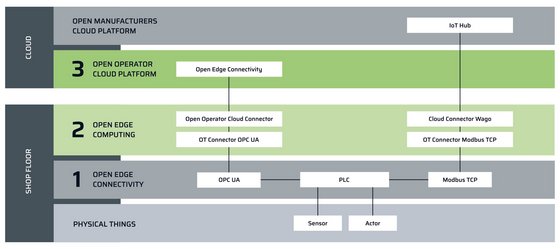
Open Edge Computing
The case tests a variety of methods in two different formats for accessing and processing the data from the end devices on the factory floor. However, much of this is still "work-in-progress", even in the largely established edge of the flow loop. In future, more members will be involved in order to complete the path to the cloud. The Alliance's Open Edge Computing (OEC) approach relies one hundred percent on commonly used and recognised industry standards, such as OPC UA and MQTT, as well as Docker in the field of microservices. The Alliance steps in to provide guidance where a standard opens up several possible options. For example, in the case of the MQTT broker, it actively defines the structure of the user data within this case, as this may be structured differently within the MQTT format. In this way, Alliance members take the path from asset and application via the process in the factory to the company as a whole and finally to common "cross-enterprise" semantics, i.e., across all the companies in the industry.
* The OI4 Demonstrator for Process Industry is housed in the Duurzaamheidsfabriek in Dordrecht near Rotterdam. The Sustainability Factory is a joint facility of the City of Dordrecht and the ROC Da Vinci College, a vocational training institution for industry.
"The Open Industry 4.0 Alliance offers a concept for an individual open edge computing platform, which was implemented in this demonstrator project. The focus was on the connection of the field level, user support during commissioning as well as the management of apps on different edge computers. This ensures that the resulting solution modules can be seamlessly integrated into the system architecture and that different hardware from different manufacturers can be supported."
